Welcome to February 2017 Curious Tea subscriptions! We have some exciting teas to share with you this month. We have selected the following four teas: a rare and interesting smoky green tea – Assam Brahmaputra Green; two teas from northern Thailand (a first for us) – a nutty Santikhiri Bai Yai Green tea from a native cultivar and Santikhiri Black Pearls made from a Jin Xuan cultivar; and finally a unique ‘bug bitten’ oolong from Taiwan – Oriental Beauty.
- Light: Assam Brahmaputra Green and Santikhiri Bai Yai Green;
- Dark: Santikhiri Black Pearls and Oriental Beauty Oolong;
- Mixed: Assam Brahmaputra Green and Santikhiri Black Pearls.
Our Discovery tea taster subscription boxes contain 10g taster pouches of all of the above mentioned teas. As always, if you are a subscriber you will benefit from a 10% discount on all teas from our tea shop!
To help you along with the tasting, here is some further information on all teas featured in our February boxes.
Assam Brahmaputra Green
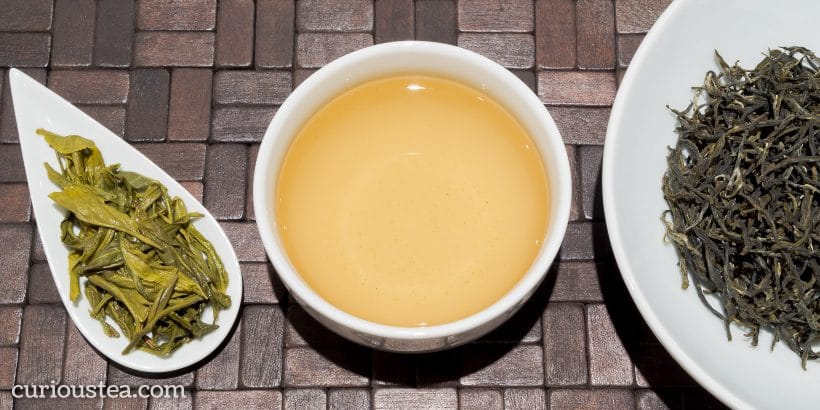
Assam Brahmaputra Green is an interesting and unusually smoky green tea from Bhartia tea estate in the east of Assam located near to the Brahmaputra river. This Assam comes direct from the tea garden where it is produced in cooperation with other nearby small farm holders and is made completely by hand. This tea was harvested in October 2016, using the local Camellia sinensis var. assamica cultivar.
This Assam Brahmaputra Green tea comes from a part of Assam that is located close to the border with Arunachal Pradesh state. It is within the Dibrugarh belt that is often referred to as the Tea Capital of the World due to the large amount of tea produced in the area. It is particularly famous for a typical Assam style of tea that has brisk and malty flavours with an appealing liquor appearance. The Bhartia tea estate is located close to local areas of natural beauty, including the Dihing Patkai virgin rain forest, known as ‘the Amazon of the East’ due to its climate and biodiversity.
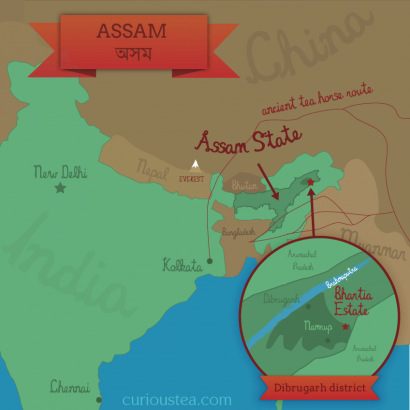
Traditionally a small holder farm like this one would supply tea at very low prices to larger factories for further processing, which in turn would sell their finished tea at auctions to highest bidders. However, with factors such as market pressures on the price of tea as well as increasing local costs such traditional methods of selling tea are becoming unsustainable for many farmers in the longer term. This is the primary reason why some smaller farmers are switching to producing high quality handmade tea that is distributed in a more direct chain to end consumers. This ensures that the farmers and the workers on the farms are paid a fair amount for their tea as it does cut out many of the middlemen present in traditional tea supply chains.
We work directly with the owners of Bhartia tea estate in sourcing this tea from them. Their family have been the owners of the estate for around a century with the estate being passed down the generations. Although they produce only a limited quantity of this tea due to labour intensive hand processing, the quality of it really is quite supreme. This hand made Assam Brahmaputra Green exhibits a more unusual character and flavour nuances that will definitely have been lost if this tea was sent to a large factory and processed into a mass product.
This Assam green tea has been hand selected and hand rolled in the traditional orthodox style of tea production. The dry large twisted leaves have a very dark green appearance and a smoky fruity aroma. When brewed, the aroma of this tea is unmistakably smoky, yet fruity. It is a far cry from a Lapsang Souchong, so don’t be put off by the smoky character – it is rather light, does not overpower the other flavours and is well balanced by the more common green tea fruity notes. The golden liquor has only mild astringency, with refreshing hints of smoky tart fruits. There are slightly vegetal notes of asparagus and savoury seaweed on the undertones. This tea has an overall balanced flavour with an uplifting and invigorating finish.
This Assam Brahmaputra Green tea is best brewed at 80°C for 1-2 minutes according to your taste and can be brewed around 3 times, increasing steeping time with each next brew if desired.
You can also buy Assam Brahmaputra Green tea in our online shop.
Santikhiri Bai Yai Green
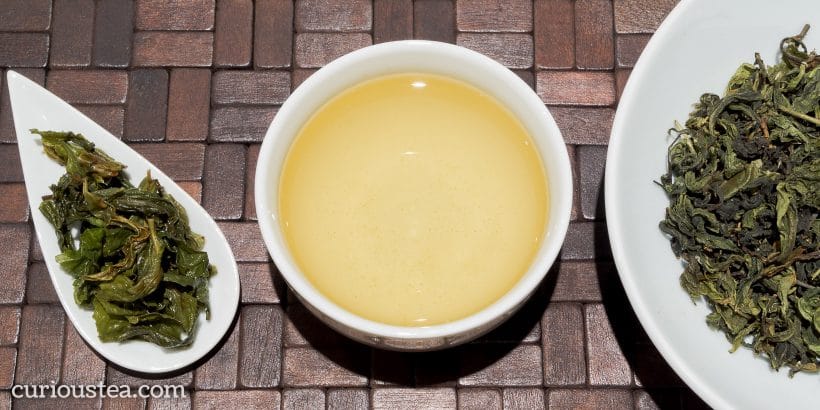
Santikhiri Bai Yai Green is another green tea that is produced from Camellia sinensis var. assamica, although this particular strain is native to northern Thailand. This tea comes from around Santikhiri village (formerly Mae Salong) that is located around the highlands of Doi Mae Salong mountain close to the borders with Burma and Laos. Santikhiri Bai Yai Green tea is grown at an altitude of around 1,200-1,600 metres and was plucked in August 2016.
Locally known as ‘Bai Yai’ or ‘Large Leaf’ this strain of tea plant has been growing wild around this part of Thailand for centuries. In fact, there are local wild tea plants just like this one around many parts of Southeast Asia, the particular strain differing from one locality to the next. While a lot of wild trees are still found around this area of Thailand, this Santikhiri Bai Yai Green tea is harvested from plants that are cultivated at a tea garden in Doi Mae Salong.
This area of Thailand is part of the Golden Triangle of Southeast Asia, the largest producer of opium from the 1950s well into the 1990s. Following eradication campaigns that started in Thailand in the 1980s, the production of opium has vastly decreased in this particular part of the Golden Triangle. It has been particularly effective in Thailand, where tea was recognised as one of the sustainable commercial crops to replace opium poppy growing. This was in a way appropriate as many of the original immigrants to northern Thailand’s poppy fields came from Yunnan in China. With a long history of tea growing, it was easier for these Yunnanese immigrants to switch from growing opium poppies to once again growing a sustainable tea crop.
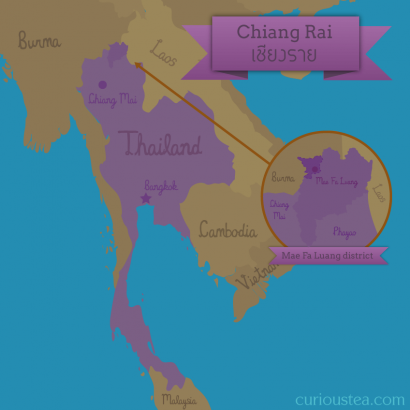
While many tea cultivars now grown in Thailand have been imported from Taiwan, the local native strain has been preserved, in some part thanks to the Yunnanese immigrants that came with the intent of growing poppies, yet stayed on to grow tea. After all there is more similarity between this native Thailand strain of assamica and the strains of the tea plant that are found in Yunnan. So the centuries old traditions of tea growing and processing from Yunnan found a new place in northern Thailand.
Santikhiri Bai Yai Green has quite large leaves (hence the local name for it) that are dark, almost mossy green in colour. The aroma of this tea is quite nutty, specifically reminiscent of almonds. When brewed, the light coloured liquor has a sweet nutty and almost creamy aroma. The taste is very clean and fresh, with sweet, creamy and nutty flavours. There is slight tartness on the aftertaste that balances the flavour quite well. This green tea particularly makes us think of sugared almonds and freshly baked sweet pastries!
For this Santikhiri Bai Yai Green tea we suggest brewing parameters of 80°C for 1-2 minutes according to your taste, brewing around 3 times.
You can also buy Santikhiri Bai Yai Green tea in our online shop.
Santikhiri Black Pearls

Santikhiri Black Pearls is a black tea that is produced from a Jin Xuan cultivar that is most commonly known for being the leaf of choice for Milk Oolong. This tea comes from around Santikhiri village (formerly Mae Salong) that is located around the the highlands of Doi Mae Salong mountain, close to the border with Burma and Laos. Santikhiri Black Pearls tea is grown at an altitude of around 1,200-1,600 metres and was plucked in August 2016.
When this area of Thailand went from growing opium poppies to sustainable tea growing, many tea cultivars were imported from Taiwan in order to quickly establish a booming tea industry. Taiwanese cultivars were particularly attractive since the growing conditions that the Taiwanese cultivars were selected for matched well the growing conditions of northern Thailand. Furthermore many consider Taiwanese teas to be of fantastic quality hence fetching a premium price, something Thai tea growers were understandably attracted to. It is safe to say that while teas grown in Thailand still have some way to go in matching the top tier Taiwanese teas, the offering from Thailand is certainly of a very solid quality and generally an attractive price point for consumers.

This Santikhiri Black Pearls tea is a black tea that is made from the Jin Xuan Golden Daylily (金萱) TRES #12 cultivar. This cultivar is used in making Milk Oolong and is famous for its creamy and milky aroma, mouthfeel and taste. However this Santikhiri Black Pearls tea has a real twist. Instead of keeping it as a partially oxidised Milk Oolong, it has undergone almost full oxidation (85-90%), resulting in a tea that is black, or almost black. It is hard to call this tea ‘completely’ black as the character is very light and it exhibits minimum tannins and aftertaste associated with black tea. Perhaps it is more similar to a Dian Hong (Yunnan Red) type of tea that also undergoes oxidation in the 80-90% region. For reference, most teas that are described at ‘black’ undergo oxidation of 90%+. However there are always exceptions, such as Darjeeling First Flush teas, some of which can be of very low oxidation levels, yet are still classed as ‘black’ teas.
Santikhiri Black Pearls comes in tightly rolled oolong style large leaves that resemble pearls, hence the Black Pearl moniker. The amber liquor has a nutty and sweet creamy aroma. The taste is quite light and smooth with sweet, creamy and malty notes of nuts and cocoa. There is no astringency or tannins, making this a super smooth and balanced cup of tea.
We suggest brewing at 90°C for 3-4 minutes according to your taste. Santikhiri Black Pearls tea can be brewed around 3 times.
You can also buy Santikhiri Black Pearls black tea in our online shop.
Oriental Beauty Oolong

Oriental Beauty Oolong, also known as Dong Fang Mei Ren (東方美人) or Bai Hao “white tip” (白毫), is a unique oolong that originates from Taiwan, sometimes also known as Champagne Oolong! The origin of the Oriental Beauty name has a few legends around it, including being named by either Queen Victoria or Queen Elizabeth II. While it is a nice sentiment that attests to the importance of tea in British culture, it does seem that it is only a legend, perhaps one that has been used to market this tea in the past.
Oriental Beauty oolong is classed as a ‘beauty tea’, which is a highly unusual class of oolongs, affected by the presence of little green leaf hoppers that nibble the tea leaves during growth. The tea plants react to this attack by producing more polyphenols, which during processing give the unique ‘beauty tea’ flavour, usually described as a honey-like taste and aroma. Oriental Beauty Oolong is perhaps the most well-known example of a beauty tea and represents a heavily oxidised oolong, which can sometimes be incorrectly classed as a black tea. However, there are also other less oxidised varieties such as Gui Fei and Mi Xian.
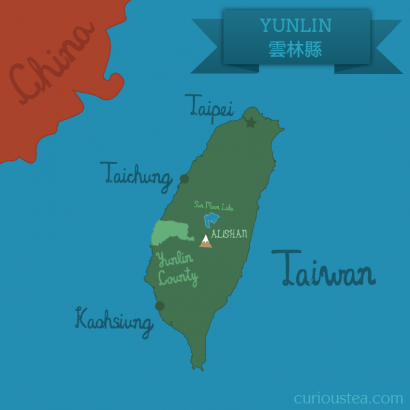
Our Oriental Beauty Oolong is made from a Qing Xin (青心) or Green Heart cultivar grown around mountain peaks between Alishan and Shanlinxi in Yunlin county, Taiwan. It is grown at an altitude of 800m and was harvested in August 2016.
This is a tippy oolong that comes in loose (rather than rolled) form, which is less common for Taiwanese oolongs. As it is heavily oxidised, this creates an interesting blend of the ‘beauty’ flavour with a depth of a darker oolong. The rich golden liquor has a typical wild-honey and floral aroma and the taste has similar qualities. The highly notable honey taste comes through the medium robustness of a fruity and mildly floral oolong, resulting in a balanced and smooth flavour. There is no astringency or tannins, making for a easy and comforting cup.
Oriental Beauty Oolong tea is best brewed at 90°C for 3-4 minutes according to your taste. It can also be brewed 3 or more times, slowly increasing the steeping time with each subsequent brew.
You can also buy Oriental Beauty Oolong tea in our online shop.
We really hope that you enjoy the tea club selection for February and are looking forward to what we have in store for your March boxes!
If reading this has piqued your interest, but you don’t yet subscribe to our monthly tea selections and would like to receive them in the future, you can set up your tea subscription in just a few clicks. We ship worldwide from London, UK.
We always love to hear from you, so if you have any questions, suggestions or just want to chat about tea, email us at contact@curioustea.com, via our Facebook page or via Twitter.
You can also follow us on Instagram for pretty tea photos.
Happy tea tasting!

